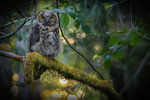

A friend telephoned me earlier this week. “They’re hooting!” he reported. He lives near one of the city’s wooded parks, and each year about this time he hears Great Horned Owls calling their loud territorial hoot. Possibly you’ve heard it – a deep-voiced quick Hoo, Hoo, Hoo followed by a longer Hoooo, Hoooo. Often you will also hear a fainter answering call from another owl some distance away.
These owls are our classic image of a storybook owl, standing upright and tall, with an oval face, bold forward-facing yellow eyes and large, obvious feathered tufts (the “horns,” which look more like ears). Owls – especially Great Horned Owls -- have a long history of mythical connections to humans. It’s no wonder; they have mysterious nocturnal habits and ephemeral hoots. And on the relatively rare occasions when we encounter one, we are confronted by a piercing, inscrutable stare.
Although nocturnal, Great Horned Owls are bold and come out well before dark, flying to a prominent hunting perch, usually overlooking open ground. Look for them on a perch or utility wire, silhouetted against the fading light of dusk. If it’s still light enough, you’ll see their sooty, gray-brown plumage.
December is the start of their breeding cycle. They don’t make nests; they usurp the nest or cavity dwelling of another bird. Sometimes a sharp-eyed observer will see the brooding female peeking out of an old hawk’s nest. Typically, they lay two eggs. The young leave the nest well before they can fly, hopping from branch to branch, and squawking for their parents to feed them.
A number of years ago, while out on Ft. Lewis tending bluebird boxes, I heard that strange squawking. Eventually, I managed to sneak up on a juvenile Great Horned Owl with full wing feathers but elsewhere still downy. Then I heard a second, also calling to be fed. One of Liam’s accompanying photos shows a similar juvenile, with just the beginning of its ear tufts.
Great Horned Owls are widespread in both North and South America. They adapt very well to many habitats, including in and around urban areas. They’re aggressive predators, catching a wide variety of prey, from mice and rats to skunks and even other owls. They may even take the occasional house cat or very small dog that’s out in the evening.
Barred Owls
There’s a second large owl that is heard more and more in recent years vocalizing from our Thurston County woodlands, and that’s the Barred Owl. These owls also have a loud hooting vocalization, but it’s not as deep as the Great Horned and has a much different rhythm. Their hooting is often transcribed as a repeated “Who Cooks for You?” though not everyone agrees with that “translation.”
Barred Owls also stand upright and also have an oval face (called facial disk, see photos), but their heads are rounded and there are no feathered tufts. They are mottled brown overall, with dark eyes and vertical bars on their chests. They were rare in our area 20 years ago, but the Christmas Bird Counts (see last week’s column) tell the tale of a steady increase of this species invading and occupying a new territory.
Habits to watch for
Both these species are big birds, larger than a Red-tailed Hawk. During the day they perch motionless on tree branches. In the winter, they are easier to spot. To me, they look like a vertical pile of brownish leaves. When I walk through the woods, I’m always checking out those random leaf piles. And sometimes the crows help schuss them out. When crows spot an owl, they instinctively raise a loud alarm and fly around the owl. This behavior is called “mobbing” and usually results in the owl flying off.
As they fly, you may notice one of the other features of all owls – they fly nearly silently. Their specialized wing feathers have a feature that softens and eliminates the noise caused by the turbulence of the air passing over the wing during flight. Quite a talent to be able to employ if you are a night hunter!
Coming this Sunday
Reminder: This Sunday, December 18 is the day you might spot teams of birders out and about. It’s the Olympia Christmas Bird Count, with over 80 teams walking on organized routes counting numbers for all bird species. From this tabulation, we will have a good census of what birds are to be found in our area this winter.
George Walter is environmental program manager at the Nisqually Indian Tribe’s natural resources department; he also has a 40+ year interest in bird watching. He may be reached at george@theJOLTnews.com
Photos for this column are provided by Liam Hutcheson, a 15-year-old Olympia area birder and avid photographer.
1 comment on this item Please log in to comment by clicking here
PegGerdes
We've seen mobbing by crows of a Barred Owl at least twice in Mission Creek Nature Park lately. Thanks for a great article!
Friday, December 16, 2022 Report this